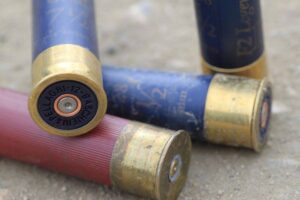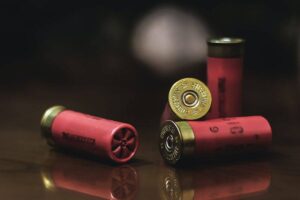Table of Contents
Shell gauge is one of the essential attributes determining the shotgun you buy. Besides gauge, another shell quality influencing a buyer’s decision is the shotgun shell type: Low brass vs High brass.

Low brass and high brass shotgun shells have slightly similar qualities, especially gauge. However, there are significant differences between the two shells.
We’ve provided a detailed review of the two shells below, highlighting major similarities and differences.
We’ve also shared our opinion of the shells and whether it’s worth it to buy the low-brass or high-brass shotgun shell.
High Brass Vs Low Brass Shotgun Shells: Differences
Even though high brass short shells and low brass short shells look the same, they have a lot of differences.
You may not notice these differences until you start using the shells. Below are some obvious and subtle differences between High brass vs Low brass shotgun shells
Prices
The price range is the most pronounced difference between High brass vs Low brass shotgun shells.
High brass shells are more expensive than low brass as a result of some extras that come with the shell.
The Quantity of Gunpowder
High brass shotgun shells come with larger quantities of gunpowder than low brass shells.
The name low brass comes from the size of the compartment holding the gunpowder, which also accounts for the quantity of gunpowder it can hold.
Shot Velocity
Pellets (shots) fired from high brass shells move quite faster than those from low brass shells. It still holds even if they are fired from the same shotgun.
The speed is due to the volume of gunpowder. Since high brass shells contain more gunpowder than low brass shells, the speed is bound to be higher.
Shotgun Recoil
The recoil felt with the high brass shell has a higher impact than recoils from the low brass shell. The recoil impact is due to the higher gunpowder in the high brass shell.
The low brass shell contains a lesser quantity of recoil, making the impact quite mild.
Shot Accuracy
It may not be an obvious difference to beginners. However, as you begin to develop your shooting skills, you’ll discover that shots fired from high brass shells offer more accuracy than low brass shells fired from the same distance.
Shell with a larger DRAM EQ rating (`1250+ fps) Always offers improved control and accuracy.
Shot Spring
Shots fired from low brass tend to cover a larger surface area on the target than the high brass. I.e, it has a wider shot spring.
This quality becomes critical when deciding to purchase a home defense shell. Concentrated pellets from high shells could limit the impact of the shots, which would be a disadvantage.
Shell Power Difference
The High brass shell holds more power than the low brass shell. For example, a 20-gauge, 2-1-quarter shell that comes with 1 1/8 oz and 1200 fps (feet per second) has less power than similar shells but with 1400 fps (feet per second).
The FPS rating indicates the volume of gunpowder in the brass. A higher fps rating indicates high brass shells and a lower fps rating indicates low brass shells.
The power of a shell is first indicated by the volume of gone powder it contains.
Firing Cycle
In some shotguns, it’s possible to find that low brass shells don’t cycle well. This problem has nothing to do with the quality of the shell. The problem is with the mechanism of the shotgun.
There may be a need for more power to be delivered into the hull to generate a recoil that provides the needed recycling.
If this process is not aligned with the suggested tip, the shotgun will not cycle properly. Low brass shells contain a lesser amount of gunpowder, which means that less expansion would be generated in the hull.
It accounts for the cycle problem experienced in some shotguns. This issue might not be obvious in most guns, but it’s something to keep in mind when deciding which shell works best for you.
High Brass Vs Low Brass Shotgun Shell: Similarities
It’s critical to mention that the similarities between shotgun shells are relative. There could be slight changes from one brand to another.
However, the similarities highlighted below still hold in most cases, especially if you stick with shells from the same brand.
Base Diameter Dimensions
The base dimension of both high brass and low brass shotgun shells is the same. However, it’s different if they have different gauges.
They have the same configuration. The base holds the primer in high brass and low brass.
Similar Gauge
Brass variations don’t affect the shell gauge. If it’s a twelve or twenty gauge, it’ll be the same for both the high brass shotgun shell and low brass shotgun shell.
Gauge only affects diameter and varies from one shotgun shell category to another.
Pellet (shot) Sizes
Low brass and high brass shotgun shell Pellet sizes are mostly the same for similar shell gauges. Variations come in BPs when the shot diameter changes and not as a result of brass sizes.

Is Low Brass Shells Worth Buying?
Yes. Low brass shotgun shells have an equal advantage as high brass shotgun shells. The shotgun shells you buy depend on the task you intend to perform.
High brass shotgun shell works best for Hunting or home defense. It gives you an increased shot spring, which is effective for dispersed targets.
However, when you are shooting for sports events or aiming at a more specific target, high brass is the way to go.
What Do We Think About High Brass Or Low Brass Shells?
High brass and low brass shotgun shells have their upside and downside. None of the shells comes with a type disadvantage or advantage.
The situation in which they’ll be used determines which shell offers you the highest and best results.
Also, the price range you can afford would determine the shell you buy. In most cases, high brass shells come at a higher price than low brass shells.
Another factor you may want to note is the recoil. Higher gunpowder quantity equals higher recoil.
If you’re not efficient at controlling high-impact from recoil, it can influence your accuracy, especially for beginners.
Are High Brass Shells Better Than Low Brass Shells?
This question does not have a yes or no answer. The answer depends on who holds the gun and what the gun is aimed at.
A beginner holding a high brass in a James Purdey & Sons gun aimed at a target might perform poorly, and a pro holding a low brass shell in a Beretta gun may shoot down a target positioned a hundred yards away.
Conclusion
One of the most important things to remember about the shotgun shell is that the higher the brass, the more the gunpowder, and the lower the brass, the lesser the gunpowder. It is the gunpowder that determines the power of the shell.
Some people argue that the brass power delivered to the shots does not depend on the brass height. However, a simple look at the ammo carton would show you otherwise.
Shots with Higher fps have higher power than those with lower fps. In most cases, high brass shells come with higher fps.

